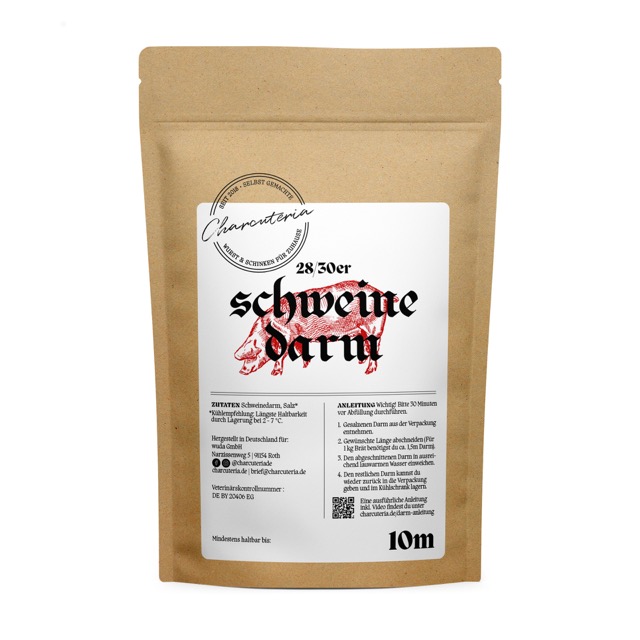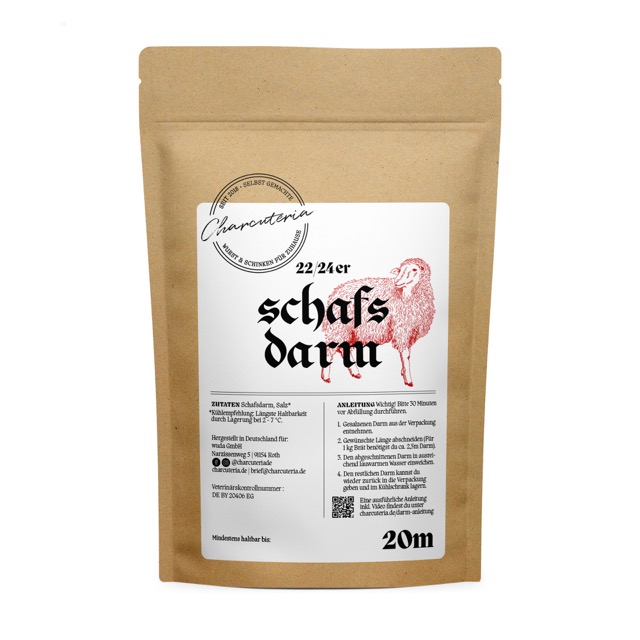Do you want to learn more about sausage casings, do you ask yourself which casing is the right one for your sausage, or where you can buy sausage casings? Then you’ve come to the right place
Broadly speaking, there are three different types of “casings” for your sausage. Natural, artificial & plastic casings. You can read about the exact differences right here in this post.
Once you’ve determined the type, it’s a matter of figuring out exactly which type you need. For that case, I’ve listed most casing types for you here along with the sausage in question.
And at the end I have a little buying advice for you.
I wish you a lot of fun while reading and hopefully while making your own sausage.
Table of Contents
The different types of sausage casings / sausage casings
Sausage casings can generally be divided into two types…
Natural ones like casings from beef, pigs or sheep
I use mostly natural casings for making anything that is going to be fried and eaten with it. For the production of raw and cooked sausages I mostly use special artificial casings.
Especially for sausages I prefer natural casings, because they have a softer, tastier “bite” and it has simply proven itself as a method
Artificial casings, which are divided into several subgroups:
Fibrous casings, for example, are made specifically for the purpose of preparing dried and semi-dried sausages. Since they can also be smoked, they are ideal for this purpose.
Cellulose casings are often used in commercial sausage production and are rarely used privately
Plastic casings are ideal for filling cooked sausages, such as cold cuts or even cooked sausages like liver sausage.
Natural ones such as collagen casings, which are made from synthesized natural protein and are edible, artificial ones such as cellulose and plastic casings, which are not edible and must be removed before the sausage is eaten.
Which casing for which sausage
I first wrote down for you a selection of casings that are available. This is a generic summary of most of the casings available. You’ll find advice for amateur sausage makers in the next section.
Pork Casings
Pork casings are easy to work with. They are sturdy, making them less prone to holes. They come in various lengths and diameters.
Small intestine
| Caliber 28/30 | All grilled and Bratwurst sausages, boiled sausages, garlic sausages, Polish and country sausages, mini salami, Mettenden |
| Caliber 30-32 | Bockwurst, Breakfast Sausage |
| Caliber 32-35 | Thicker sausages, Weisswurst, bockwurst, knackwurst etc |
| Caliber 35-38 | Bockwurst, Knackwurst, Bockwurst, Polish etc |
| Caliber 35-38 | Polish, mortadella, liver sausage, pepperoni |
Smaller intestine or large intestines, fit perfectly for blood sausage or liver sausage, sopressata, air-dried salami
Butte is the appendix. This is mostly used for aspic, pressed sausage or boiled sausage varieties.
Fat intestine is suitable for a veal liver sausage or yellow sausage.
Stomach and bladder are suitable for pressed sausage, Saumagen or cooked sausage.
Beef casings
There are four types of beef casings. Rounds, middles, caps and bladders
Wreath casing (caliber 32/35 to 46/+) is suitable for liver sausage, blood sausage, Mettwurst.
Medium casing (caliber 40/45 to 70/+) is used for cooked sausage, ham sausage, plockwurst and also salami.
Butte is used for sliced sausage.
Fatty / fat casings is suitable for boiled sausage, mettwurst or raw sausage varieties.
Sheep casings
Sheep casings are considered the highest quality small diameter casings and are used to make many sausages. They come in a variety of lengths and diameters.
The quality here can vary, so it is important to find a high quality manufacturer.
Saitling (caliber -/16 to 28/+) is used for Vienna sausages, pepper bites, Nürnberger Rostbratwurst.
Mutton is suitable for hunting sausage or various raw sausages.
Collagen casings & casings
Collagen casings are natural because they are made from natural protein from bovine hide. The inner skin layer consists of fat and collagen (collagen is also found in natural casings)
The inner layer undergoes a process that includes drying, removal of fat, dissolving and reconstituting as a collagen casing. I don’t know the details, but the result is a casing made from a natural product
Because they are man-made “casings,” they have a uniform shape and size and are available in clear or mahogany
They are sometimes used to make larger, dry or semi-dry sausages. Although edible, it is usually removed either before or after the sausage is sliced because it is tough.
Cellulose casings & casings
Cellulose casings are used by commercial manufacturers to make skinless sausages of the wiener or hotdog variety. They are made of solubilized cotton linters and are uniform, strong and resistant to bacteria. I’ve never used them and doubt you’ll ever have a reason to use them.
Synthetic casings & sleeves
These are commonly used by mass producers. It is made from alginates , requires no refrigeration, comes in a variety of colors or as a clear casing, has a uniform shape, and is very tear resistant, which is why it is so commonly used by mass producers. I don’t use it and doubt you’ll ever have a reason to.
What casings to use as a home sausage maker?
I’ve explained a lot of casings to you in this post. In my experience, you only need a small selection to make most types of sausage at home.
- Pork casings caliber 28/30 for the production of thicker Bratwurst or smaller raw sausages (Pfefferbeisser, Mini Salamis & Co) or boiled sausages, such as bockwurst
- Sheep casing caliber 22/24 for the production of thinner bratwursts, salami sticks or boiled sausages, e.g. Vienna sausage.
- Artificial casings for the production of cooked & boiled sausages. Here there are the most different calibers. For cold cuts(ham sausage, beer ham, etc.) I mostly use caliber 60/25 and for cooked sausages like liver sausage I use 45/25.
- Smokable artificial casings. These are suitable for smoking and making raw sausages due to their special properties. Caliber 55/25 is my go-to.
Because you can get very far with this selection, there are also only these in my EU store. Of course, there may be an exception for special sausages. In over 95% of cases you are on the safe side with these casings + canning jars.
Where can you buy sausage casings?
If you want to buy casings, you can do it both in local stores and directly online.
Buying pork casings – Which & for what?
Pork casing caliber 28/30
This type of casing is especially suitable for making thicker sausages and also slightly thicker boiled sausages. EU? You can get the pork casing in my store.
Sheep casing buy – Which & for what?
Sheep satiling caliber 22/24
This casing is particularly suitable for the production of thinner sausages and thinner boiled sausages such as Vienna sausages. EU? You can get this one also in my store.
Buy artificial casings – Which & for what?
When choosing artificial casings, there are two different categories that I personally recommend:
Artificial casings for boiling & cooking sausages
For artificial casings, I recommend you buy artificial casings caliber 45/25 for a smaller diameter and artificial casings caliber 60/25 for a slightly wider gating.
Smokable artificial casings
For the maturation of raw sausage you need special artificial casings. I recommend fiber casings in caliber 55/25 for the production
The casings can also be smoked and support the ripening process ideally




